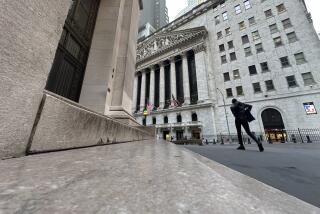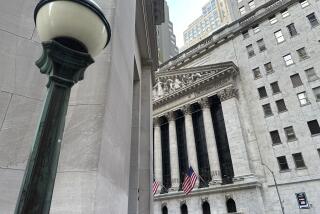Wall Street Mood Swing : Dip in Stock Prices Ends an Otherwise Strong First Quarter; Dollar’s Travails Continue
- Share via
Wall Street closed a great quarter on a down note Friday, as a renewed plunge in the punch-drunk dollar left stocks mixed and bond yields slightly higher.
Yet many money managers say they’re finding it tough to be too pessimistic about U.S. markets’ prospects, with a “soft landing” for the economy seemingly on track as the second quarter begins.
“There’s been a big mood change in the markets over the last three months,” said Eric Miller, investment strategist at DLJ Securities in New York.
Indeed, despite a dollar free fall, mixed economic signals and the Mexican financial crisis, U.S. stocks zoomed to record highs in the first quarter and bond yields fell back to last summer’s levels.
The Dow industrial average slipped 14.87 points to 4,157.69 on Friday, but it still gained 323.25 points for the quarter, an 8.4% rise that was the best quarterly gain since the first three months of 1991. The Dow’s peak was set Thursday, at 4,172.56.
*
On Friday, as during most of the quarter, stocks shook off the dollar’s travails.
In a surprise, the dollar tumbled to another record low against the Japanese yen and also sank against the German mark, even though both Germany and Japan reduced short-term interest rates on Friday in an attempt to lessen the allure of their currencies.
The dollar had rallied on the announcement of the German Bundesbank’s rate cut on Thursday, but traders said the Bank of Japan’s failure to cut a key rate on Friday sparked new dollar selling.
The Japanese central bank said it had helped push money market rates to record lows this week, but was “undecided” about cutting its official discount rate.
When rumors about the U.S. Federal Reserve System stepping in to buy dollars proved false, traders pounded the buck anew.
At the close in New York, a dollar bought 86.60 yen, a record low and a decline from 89.58 Thursday. Against the mark, the dollar slumped to 1.376 from 1.409.
Traders say that despite lower interest rates in Germany and Japan, the huge U.S. budget and trade deficits guarantee a global oversupply of dollars, and that glut is depressing the buck’s value. “I think it’s just going to keep ratcheting lower,” said David De Rosa, a director of foreign exchange at Swiss Bank in New York.
But Wall Street has increasingly come to view the dollar’s fall as a crisis for Germany and Japan, not for the United States. American export prices are falling overseas with the dollar, boosting U.S. firms’ competitiveness.
“Obviously a weak currency hasn’t been bad for our stock and bond prices,” said Alfred Kugel, investment strategist at Stein Roe & Farnham in Chicago.
In the U.S. bond market, the 30-year Treasury yield ended at 7.43% on Friday, up from 7.41% Thursday but down from 7.88% at year-end. The yield fell to 7.31% last Monday, its lowest since June.
Bond yields have dropped as signs of a slowing economy have convinced many investors that the Fed’s interest-rate hikes of 1994 will accomplish their goal: an economic “soft landing,” whereby growth stays positive but at a more moderate and low-inflation pace.
Some Wall Streeters argue that long-term bond yields have much further to slide if inflation stays around 3%, which leaves the “real” rate of return on a 30-year T-bond at a historically high 4.4%. “Long-term rates are still way too high compared to where we think inflation is going,” said Scott Grannis, chief economist at Western Asset Management in Pasadena.
The soft-landing scenario also continues to cheer stock bulls, though many say the market is overdue for a short-term pullback of at least 5%.
Blue-chip stocks scored the best gains in the quarter, benefiting from expectations of sustained economic growth and from a “flight to quality” by investors disillusioned with crumbling Third World stocks.
*
Smaller U.S. stocks fared less well, but still were up handsomely. The Russell 2,000 index of small stocks rose 4.2% for the quarter, an annualized return of 18%.
Despite stocks’ gains, many analysts say that share prices aren’t significantly overvalued relative to earnings.
The average blue-chip stock is priced at 15 to 16 times estimated 1995 earnings per share, which is “not cheap, but not expensive either,” Kugel argues. And as bond yields fall, stocks look more attractive, he notes.
The place not to be in the first quarter: Most foreign stock markets, which either suffered from too-strong currencies (like Germany and Japan) or internal problems (like Mexico).
Likewise, commodity markets overall were unimpressive, even though gold jumped $5.70 an ounce on Friday, to $392.20, on supposed inflation jitters. The Commodity Research Bureau index of commodities fell 1.6% in the quarter.
(BEGIN TEXT OF INFOBOX / INFOGRAPHIC)
First-Quarter Fireworks
Despite a plunging dollar, U.S. and foreign bond yields fell sharply in the first quarter as the world economy appeared to slow. But while the U.S. stock market posted handsome gains, most foreign stock markets slumped.
Key stock index prices changes, first quarter: S&P; 500: +9.0% Nasdaq composite: +8.7% Dow industrials: +8.4% S&P; mid-cap: +7.8% Dow utilities: +3.4% Hong Kong/Hang Seng: +4.8% Britain/FTSE 100: +2.4% France/CAC 40: -1.2% Germany/DAX: -8.7% Japan/Nikkei-225: -18.2% Mexico/Bolsa: -22.8%
Note: Changes in local currencies.
BOND YIELDS SINK
30-year Treasury bond yield, weekly closes:
Friday: 7.43%
THE DOLLAR IN YEN
Daily closes through the first quarter:
High: 101.4
Friday: 86.6
THE DOLLAR IN MARKS
Daily closes through the first quarter:
High: 1.56
Low: 1.37
Friday: 1.38
Source: TradeLine
More to Read
Inside the business of entertainment
The Wide Shot brings you news, analysis and insights on everything from streaming wars to production — and what it all means for the future.
You may occasionally receive promotional content from the Los Angeles Times.










